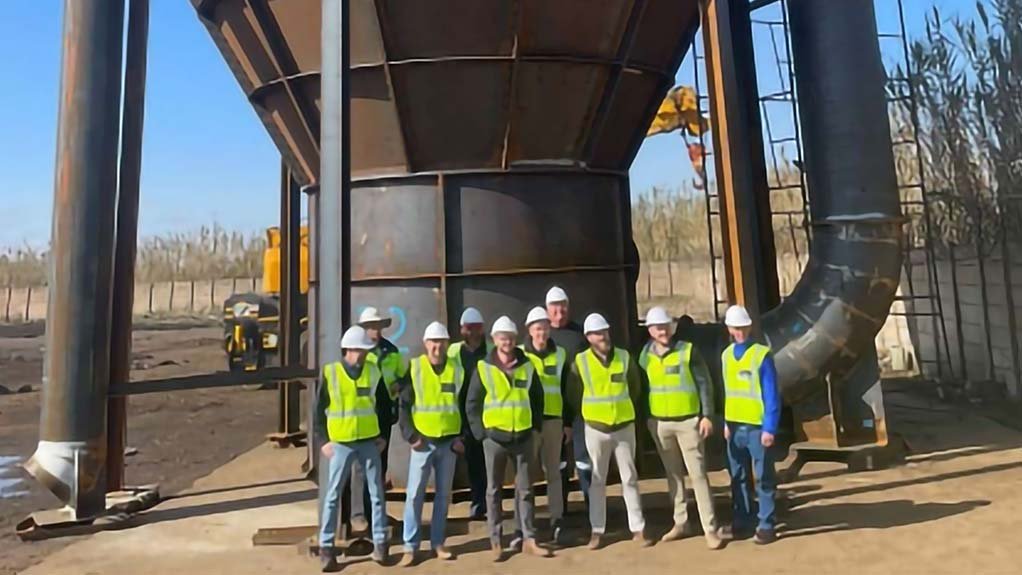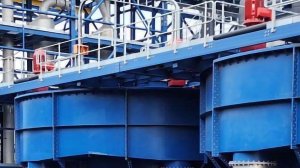Azmet Reactor project: a precise and praiseworthy victory for South Africa’s steel sector
This article has been supplied as a media statement and is not written by Creamer Media. It may be available only for a limited time on this website.
Fabricating six massive reactors that are over three storeys high in Gauteng and then transporting these more than 2 500 kilometres to a mine in the Democratic Republic of Congo (DRC) - where all 3265 parts fitted perfectly, with not even one of the 26 900 bolts out of place - is a massive achievement.
This is according to Southern African Institute for Steel Construction (SAISC) CEO Amanuel Gebremeskel, commenting on the Azmet Reactor project, a collaborative effort led by Viva Engineering, an innovative and deserving 2023 Steel Awards Mining and Industrial category winner.
“The project entailed the detailed design of complex geometry with finite element (FEM) modelling, and integrated support frame and platform. As such, it exemplifies precision engineering, showcasing intricate design and fabrication processes.To appreciate the complexity thereof, one has to consider how to plan, design and fabricate such huge modular structures ahead of time, in such a way that they can be moved through four or five different countries by road to install on site at the mine,” Gebremeskel says.
He goes on to explain that the more conventional approach would be to use heavy concrete tanks; or set up a substantial design office and fabrication works with a highly skilled team, both of which are not readily available locally in the DRC. Using an established South African fabricator based in Gauteng therefore provided a viable alternative - allowing for a controlled environment and close monitoring to ensure that all construction materials and structures met the required quality and safety standards.
Poring over the project
The Azmet Reactor project not only involved creating six huge reactors - but also, several other complex tanks, as well as platework and plant buildings.
From a technical point of view, engineers had to consider the design of the vessel in relation to permanent, material, equipment and wind loads. Due the nature of the spliced connections, these had to be modelled in detail, including all the bolts. Furthermore, as the vessels had to be transported and erected piece by large piece, a lifting study first had to be performed. This focused on the selection of the most appropriate lifting methodology, considering that the reactor components would need to be loaded onto conventional heavy-duty transport vehicles.
On the opposite end, at the mine in the DRC, careful consideration was given to the constructability of the project.
Shaping up and shipping out
Gebremeskel says that the aspect of this project that stood out the most during the judging process was the logistics: “They designed each large structure in a modular fashion, for ease of transport and installation. However, bear in mind that these structures have a diameter of 9.9 metres and a height of 11.6 metres – which is almost the size of a 3-story building!”
The road transportation therefore necessitated exacting tolerances to ensure safe and timely delivery to site in the DRC.
Transport jigs were designed and built to brace the components and reduce vibration during transportation, while meticulous load packing optimised weight distribution for the lengthy trip.
All the components of each reactor were packed so that upon arrival on site, it could be assembled from the designated package. The components also had to be carefully packed in specially designed cradles to optimise each load and minimise the number of loads to site
“The essential brilliance of this project lies in the smooth coordination and orchestration of design, fabrication and erection. This process was perfectly choreographed by the project managers who oversaw the planning down to the finest detail,” Gebremeskel observes.
Reactors are essentially large tanks that are custom-made to remove precious metals from mined ore, and must tolerate a variety of different temperatures and chemicals. A rubber bladder required to protect the steel from these compounds therefore also had to be installed prior to leaving the Viva Engineering workshop in Gauteng.
Here too, Gebremeskel says, adjectives such as ‘innovative’ and ‘ingenious’ come to mind.
“The lining is put on the inside to protect the steel from whatever solvent is being used. As one can imagine, it is necessary to do some fairly detailed mockups and even trial assemblies to test this. The reactors were eventually bolted together. This meant that the lining had to work in a bolted tank rather than a conventionally welded one,” he points out.
Maintaining the continuity of the rubber lining between the bolted faces of each component was successfully addressed, as the project brief explains: ‘The first reactor was trial assembled to prove that the jigs and manufacturing was correct. All six rubber-lined reactors were installed without a single flange hole out of place. Rubber lining is continuous on the bolted faces. This required that the fabrication details incorporated the lining thickness. During fabrication, spacer plates were also inserted in the connections to simulate the lining. Corrosion protection was furthermore applied to the external surfaces of the component’.
Joining quality with manufacturing excellence
Yet another innovative aspect of the Azmet Reactor project is the precision welding required to join the panels during the fabrication process, so they could be bolted together once on site. The level of welding precision and accuracy had to be very high, as the structures could not distort during the transportation process.
“A lot of the design had to cover exactly how to lift and maneuver these large and very heavy modular structures. The most significant load is during the lifting process - as opposed to when they are in use - entailing a very different kind of engineering. The entire design is driven by how one plans to construct and then transport each structure - as opposed to its ultimate application,” Gebremeskel continues.
The benefits of steel in this project were numerous, as detailed in the project brief: ‘The complexity of the reactor geometry is best suited to fabrication in steel. Construction of the reactors…in concrete would not be viable due to the complexity of formwork and deployment of plant onto a site of limited size. The benefit of steel for this application is a relatively lightweight structure (compared to concrete), which can be preassembled and trial-erected before being transported to site. This allows for fast and accurate erection in the final location’.
A precise and praiseworthy precedent
One of the chief challenges, according to Gebremeskel, was completing the project on time - as late delivery would have resulted in substantial penalties. Needless to say, timeous delivery was achieved against all odds.
“The Azmet Reactors project represents a veritable feat of engineering – showcasing brilliance of design, logistics and installation – and demonstrating the South African steel sector’s capability to execute structurally and logistically complex projects with praiseworthy precision.
This is indeed a victory for our industry, which could certainly not have been achieved elsewhere on the continent. Considering the number of mines being constructed throughout Africa, the good news is that similar projects will no doubt be required, which our local steel supply chain can certainly deliver,” he concludes.
Comments
Press Office
Announcements
What's On
Subscribe to improve your user experience...
Option 1 (equivalent of R125 a month):
Receive a weekly copy of Creamer Media's Engineering News & Mining Weekly magazine
(print copy for those in South Africa and e-magazine for those outside of South Africa)
Receive daily email newsletters
Access to full search results
Access archive of magazine back copies
Access to Projects in Progress
Access to ONE Research Report of your choice in PDF format
Option 2 (equivalent of R375 a month):
All benefits from Option 1
PLUS
Access to Creamer Media's Research Channel Africa for ALL Research Reports, in PDF format, on various industrial and mining sectors
including Electricity; Water; Energy Transition; Hydrogen; Roads, Rail and Ports; Coal; Gold; Platinum; Battery Metals; etc.
Already a subscriber?
Forgotten your password?
Receive weekly copy of Creamer Media's Engineering News & Mining Weekly magazine (print copy for those in South Africa and e-magazine for those outside of South Africa)
➕
Recieve daily email newsletters
➕
Access to full search results
➕
Access archive of magazine back copies
➕
Access to Projects in Progress
➕
Access to ONE Research Report of your choice in PDF format
RESEARCH CHANNEL AFRICA
R4500 (equivalent of R375 a month)
SUBSCRIBEAll benefits from Option 1
➕
Access to Creamer Media's Research Channel Africa for ALL Research Reports on various industrial and mining sectors, in PDF format, including on:
Electricity
➕
Water
➕
Energy Transition
➕
Hydrogen
➕
Roads, Rail and Ports
➕
Coal
➕
Gold
➕
Platinum
➕
Battery Metals
➕
etc.
Receive all benefits from Option 1 or Option 2 delivered to numerous people at your company
➕
Multiple User names and Passwords for simultaneous log-ins
➕
Intranet integration access to all in your organisation

























